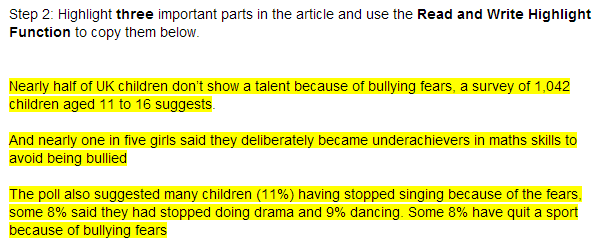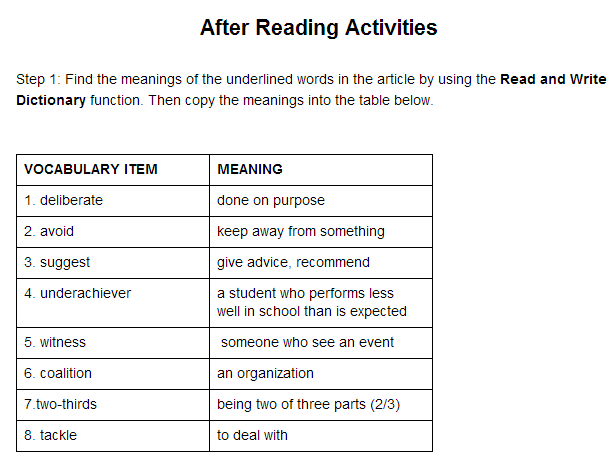Read and Write for Google Docs is an amazing free tool for any ESL student to have and use. In my previous post, I introduced Read and Write and explained each one of the productive features of the extension found only on Google Chrome. (Please click here to read the post) In a nutshell, though, Read and Write's features include an onscreen audio text reader,a standard dictionary, picture dictionary and a note collector all in one place without having to open another tab on the web browser. In this post, I will share with you an activity for Read and Write that my colleague and I came up with. Then. through this, we hope that you will have a better idea of how you can use the tool with your own students.
When we first introduced Read and Write to our students about a month ago, we were teaching a unit on bullying. We decided that a great first activity to use with the tool would be to find a short non-fiction article about bullying from a website, newspaper or magazine. We did this because my colleague and I often find that non-fiction reading is by and large overlooked in many ESL curricula, particularly in high schools. Certainly, being that most English courses in high school are literature-based, there is no doubt that teachers and students should spend the majority of their time reading and analyzing novels and the themes therein. However, non-fiction should also play a part in such courses. Most of what everyone reads in their daily lives is non-fiction, be it in the form of newspapers, magazines, e-mails, and even Facebook and Twitter posts. Furthermore, non-fiction writing includes a much different set of vocabulary and grammar structures that are often not found in novels. ESL students should be shown these forms to improve their overall understanding of the English language.
We found a short, yet very interesting news article, from the BBC on the more hidden effects of bullying in schools. In short, the article suggests that many students are afraid to show their talent in math, science, sports and music because they fear they will be teased and picked on by bullies. Most of our students tend to associate bullying with physical threats or teasing their peers on social websites, but this was a great chance for us to show that bullying has a much wider affect than they could imagine. However, it could perhaps lead them to become aware of the sheer negativity bullying causes on many different levels.
The Lesson and Activities
Step 1: The first step, prior to the lesson, was to get the news article onto Google Docs and share it with our students. We created a new Google document, and then copied and pasted the article onto it. Next, we had to make 19 copies of the Google Doc, one for each of the students in our class, so that they could make their own highlights and notes on it, plus complete the activities that will be explained below. To do this, all you have to do it click on 'File', then 'Make a Copy', and rename each copy with your students' names. Finally, you will need to share each of the documents with the students.
Step 2: Once the lesson began and we introduced the topic to our students, then we had them read the article silently to see how much they could comprehend of the native text.
Step 3: After the initial reading, we then had the students use the dictionary function on Read and Write to find the meaning of vocabulary words that we had identified and underlined in the Google Doc prior to the lesson. The students then completed the vocabulary table, as pictured above.
Step 4: Now that the students have a better understanding of the more difficult words in the article, we had them go back and read it again silently. We also assigned them the task of highlighting what they thought were the three most important sentences in the article. After that, they used the collect highlights function on the Read and Write toolbar to copy and paste their highlighted sentences to the Google Doc, as pictured below.

Step 5: Once all the students had finished, we then had a classroom discussion about the article and what they thought about it. It wasn't surprising to us at all that the majority of the students found this BBC article to be true. Many of them expressed that they, themselves, had indeed been teased in the past for being a hard-working students.
Step 6: As a final activity, because we were working on the writing process at the time, we had the students come up with thesis statements about the article. You could also have the students write a short response about their feelings about it, and what everyone can do to help decrease bullying and its effects in schools.
All in all, it turned out to be quite the productive lesson. In fact, our principal happened to drop by that day and was impressed by the Read and Write tool for Google Docs. She also enjoyed the circle-conversation we had with our students about bullying. We hope this lesson post inspires you to try Read and Write, and after which, we would love to hear any other ideas or activities that you have used with it.
Step 4: Now that the students have a better understanding of the more difficult words in the article, we had them go back and read it again silently. We also assigned them the task of highlighting what they thought were the three most important sentences in the article. After that, they used the collect highlights function on the Read and Write toolbar to copy and paste their highlighted sentences to the Google Doc, as pictured below.

Step 5: Once all the students had finished, we then had a classroom discussion about the article and what they thought about it. It wasn't surprising to us at all that the majority of the students found this BBC article to be true. Many of them expressed that they, themselves, had indeed been teased in the past for being a hard-working students.
Step 6: As a final activity, because we were working on the writing process at the time, we had the students come up with thesis statements about the article. You could also have the students write a short response about their feelings about it, and what everyone can do to help decrease bullying and its effects in schools.
All in all, it turned out to be quite the productive lesson. In fact, our principal happened to drop by that day and was impressed by the Read and Write tool for Google Docs. She also enjoyed the circle-conversation we had with our students about bullying. We hope this lesson post inspires you to try Read and Write, and after which, we would love to hear any other ideas or activities that you have used with it.






No comments:
Post a Comment